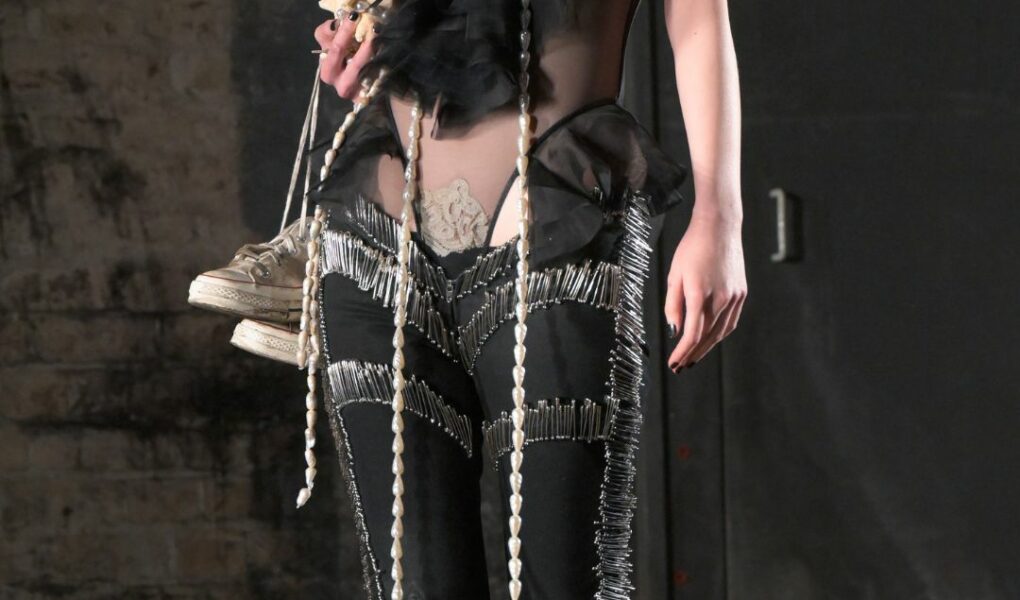Views: 108
While London Fashion Week might play second fiddle to the giants of Fashion Month—Milan and Paris—and shrink beneath the star studded glare of New York, the city itself has produced some of the most influential designers of the last five decades. From John Galliano to Alexander McQueen and Vivienne Westwood, London has long been a breeding ground for artisans with something to say.
Westwood arguably pioneered “protest fashion” calling out everything from fracking to class inequality on her runways. McQueen controversially highlighted British Colonialism in Ireland with his collection Highland Rape and Galliano released a anti-Brexit collection inspired by female spies and resistance fighters in 2019.
Honing in on individual politically charged collections does these designers a disservice – what was salient when you examine all of these designer’s legacies is a approach to fashion that left the impression of a single individual’s perspective.
The articulation of a singular creative vision, a series of collections stamped with a designer’s personality and point of view as identifiable as a fingerprint, isn’t always the most commercial approach to taking clothes to market. But, it does enrich the soul, something that’s Big Fashion has been accused of lacking in recent years. It’s this vision and individual “voice” that can still be found at London Fashion Week, fashion’s least commercially successful month in the calendar.
It was seen in spades at Dilara Findikoğlu’s FW ready-to-wear collection.
Who Is Dilara Findikoğlu?
Like Galliano and McQueen, Findikoğlu is a Central Saint Martins graduate. The Turkish-British designer has built a reputation for razor-sharp tailoring and gothic romanticism, but most importantly, for imagining a world free of men.
When she’s not designing, she’s DJing—often at the notorious Berlin nightclub Berghain. Her creative philosophy is deeply feminist, dismantling the patriarchy one skin-tight, fetishwear-inspired creation at a time. Her clothes have found a devoted following among Julia Fox, Lady Gaga, Charli XCX, Alexis Consani, Madonna, Hari Nef, Margot Robbie, and Chloë Sevigny.


Her latest collection took the phrase men are from Mars, women are from Venus quite literally, transporting audiences to a female-dominated planet. “They say women are from Venus, and so, in the act of spiritual rapture, to Venus we return,” the show notes declared. She described the collection as an escape from “destruction, subjugation, cruelty, and control.” Rather than fight within existing structures, Findikoğlu proposed an alternate reality: “Rather than look outside to find a world that actualises our full potential, we discover it within.”
Visually, the show drew on Venus, the Roman goddess of love and beauty. Models wore skin-tight, tattoo-like gowns resembling human flesh, corsets woven from braided hair, and seashell- and pearl-studded ensembles that made them look as though they were rising from the ocean depths.


Some models adopted nun-like habits; their long skirts swapped for sheer pantyhose, perhaps a nod to the many historic communities of women who have eschewed the company of men in the interest of personal and spiritual fulfilment (the pantyhose do suggest these women aren’t answering to a Christian god).
Like many St. Martins graduates, Findikoğlu has a preoccupation with corsetry, but the collection’s standout moment came in the form of the instantly iconic “Birth of Venus” jeans. Pivoting scandalously low at the crotch (we’ll wait to see them on Julia Fox), they were paired with leg-hugging leather pants. A sheer floor-length gown was trimmed with phoenix-like feathers, adding to the collection’s mythic, untamed energy.
It was a theatrical, provocative spectacle packed with viral moments proving that fashion can still be noisy, political, and very good.
At Dilara Findikoglu’s Venus In Chaos


















The post Dilara Findikoğlu’s Venus In Chaos Showed Why London Fashion Week Is Still Important appeared first on ELLE.



